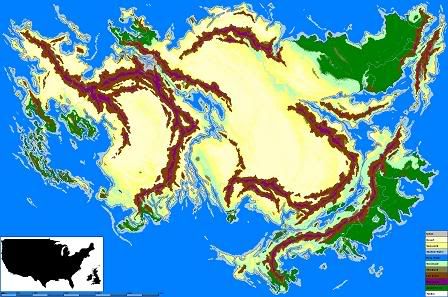Difference between revisions of "Freethinker Mainland"
Freethinker (Talk | contribs) m |
Freethinker (Talk | contribs) m |
||
| (One intermediate revision by one other user not shown) | |||
| Line 1: | Line 1: | ||
== Overview == | == Overview == | ||
| − | The Mainland is the largest and oldest part of [[The Freethinker Commonwealth]]. Home to 90% of the [[Freethinker]] population, the island is mostly a large barren desert, dominated by several large cities on the coasts and some of the most spectacular mountain ranges in the world. | + | The '''Mainland''' is by far the largest and oldest part of [[The Freethinker Commonwealth]]. Home to 90% of the [[Freethinker]] population, the island is mostly a large barren desert, dominated by several large cities on the coasts and some of the most spectacular mountain ranges in the world. Indeed, the notion of the Mainland as a political and geographic entity is often hard to distinguish from that of the Freethinker Commonwealth as a whole. |
== Geography == | == Geography == | ||
| Line 16: | Line 16: | ||
'''Enviromental Issues:''' Increasing desertification, pollution concerns in major rivers and waterways | '''Enviromental Issues:''' Increasing desertification, pollution concerns in major rivers and waterways | ||
| − | |||
[[Category:The Freethinkers]] | [[Category:The Freethinkers]] | ||
Latest revision as of 20:56, 18 August 2007
Overview
The Mainland is by far the largest and oldest part of The Freethinker Commonwealth. Home to 90% of the Freethinker population, the island is mostly a large barren desert, dominated by several large cities on the coasts and some of the most spectacular mountain ranges in the world. Indeed, the notion of the Mainland as a political and geographic entity is often hard to distinguish from that of the Freethinker Commonwealth as a whole.
Geography

|
| Geographic Map of the Freethinker Mainland |
Climate & Terrain: The Mainland is dominated by its vast, untamed deserts and towering mountain ranges. Comprised of a single, supermassive landmass surrounded by many smaller islands, this continent-sized equatorial state has a dry, arid climate except in small isolated spots near the coasts and between the larger mountain ranges. Desert and semi-arid terrain account for about 80% of the total land, with the rest dominated by shrubland, mountains and thick tropical jungles.
Enviromental Hazards: Frequent sandstorms in desert regions, Hurricanes on Western and Northern shores from late spring to autumn, native wildlife.
Enviromental Issues: Increasing desertification, pollution concerns in major rivers and waterways
